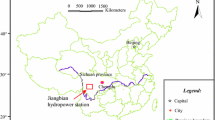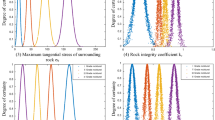Abstract
Rockburst is a serious disaster caused by the sudden release of rock energy during underground construction in high-stress environments, resulting in severe damage to underground structures. Accurately predicting rockburst intensity is challenging, and establishing a reliable and precise prediction model is of great importance. In this study, we proposed a novel hybrid model for predicting rockburst intensity by integrating rough set theory and multidimensional cloud model uncertainty reasoning. The key steps of the proposed method are as follows: (1) Rockburst cases are collected, and the maximum shear stress \({\sigma }_{\theta }\), uniaxial compressive strength \({\sigma }_{c}\), uniaxial tensile strength \({\sigma }_{t}\), and elastic energy index \({W}_{{\text{et}}}\) are used as predictors for rockburst strength. (2) The Shannon entropy method is used to determine the weights of the four indicators, and a rockburst potential expression is constructed. (3) Rough set theory is used to reduce the number of indicators to construct a rockburst strength prediction rule library. (4) Qualitative data are transformed into quantitative data using the rules library and multidimensional cloud model to establish an uncertainty inference framework for predicting rockburst strength. Finally, we compared the performance of the hybrid model with existing models, and the results demonstrate that the proposed approach achieves similar or even higher prediction accuracy. The use of cloud droplets in the model offers a significant advantage in the prediction of mixed rockburst intensities, enabling intuitive, rapid, and effective determination of the occurrence intensity of rockburst.
















Similar content being viewed by others
Data availability
All data are included in the article and its online supplementary material.
References
Adoko AC, Gokceoglu C, Wu L, Zuo QJ (2013) Knowledge-based and data-driven fuzzy modeling for rockburst prediction. Int J Rock Mech Min Sci 61:86–95. https://doi.org/10.1016/j.ijrmms.2013.02.010
Biao Z, Xing-guo D (2017) A cloud model for predicting rockburst intensity grade based on index distance and uncertainty measure. Rock Soil Mech 38:257–265. https://doi.org/10.16285/j.rsm.2017.S2.036
Chen D, Feng X, Yang C, Chen B, Qiu S, Xu D (2013) Neural network estimation of rockburst damage severity based on engineering cases. ISRM SINOROCK 2013, OnePetro
Feng X-T, Wang L (1994) Rockburst prediction based on neural networks. Trans Nonferrous Met Soc China 4:7–14
Gong F, Li X (2007) A distance discriminant analysis method for prediction of possibility and classification of rockburst and its application. Yanshilixue Yu Gongcheng Xuebao/chin J Rock Mech Eng 26:1012–1018
Gong F, Li X, Zhang W (2010) Rockburst prediction of underground engineering based on Bayes discriminant analysis method. Rock Soil Mech 31:370–377
Goodfellow I, Bengio Y, Courville A (2016) Deep learning. MIT press
He S, Lai J, Zhong Y, Wang K, Xu W, Wang L, Liu T, Zhang C (2021) Damage behaviors, prediction methods and prevention methods of rockburst in 13 deep traffic tunnels in China. Eng Fail Anal. https://doi.org/10.1016/j.engfailanal.2020.105178
Hoek E (1980) Underground excavations in rock. Inst Min Metall. https://doi.org/10.1201/9781482288926
Jin-Lin Y, Xi-Bing L, Zi-Long Z, Ye L (2010) A fuzzy assessment method of rock-burst prediction based on rough set theory. Met Mine 39:26
Kamran M, Ullah B, Ahmad M, Sabri MMS (2022) Application of knn-based isometric mapping and fuzzy c-means algorithm to predict short-term rockburst risk in deep underground projects. Front Public Health. https://doi.org/10.3389/fpubh.2022.1023890
Kamran M, Wattimena RK, Armaghani DJ, Asteris PG, Jiskani IM, Mohamad ET (2023) Intelligent based decision-making strategy to predict fire intensity in subsurface engineering environments. Process Saf Environ Prot 171:374–384. https://doi.org/10.1016/j.psep.2022.12.096
Kidega R, Ondiaka MN, Maina D, Jonah KAT, Kamran M (2022) Decision based uncertainty model to predict rockburst in underground engineering structures using gradient boosting algorithms. Geomech Eng. https://doi.org/10.12989/gae.2022.30.3.259
Kidybiński A (1981) Bursting liability indices of coal. Int J Rock Mech Min Sci Geomech Abstr 18(4):295–304
Lee P, Tsui Y, Tham L, Wang Y, Li W (1998) Method of fuzzy comprehensive evaluations for rockburst prediction. Chin J Rock Mech Eng 17(5):493–501 (in Chinese)
Li D, Du Y (2007) Artificial intelligence with uncertainty. CRC Press
Linsheng X, Lansheng W (1999) Study on the laws of rockburst and its forecasting in the tunnel of Erlang mountain road. Chin J Geotech Eng-Chin Ed 21:569–572
Liu Z, Yuan Q, Li J (2008) Application of fuzzy probability model to prediction of classification of rockburst intensity. Chin J Rock Mech Eng 27:3095–3103
Ming-Zhou B, Lian-Jun W, Zhao-Yi X (2002) Study on a neutral network model and its application to predict the risk of rock blast. China Saf Sci J 12:65–69
Pawlak Z, Grzymala-Busse J, Slowinski R, Ziarko W (1995) Rough sets. Commun ACM 38:88–95
Ran L, Yi-Cheng Y, Guang-Quan Z, Nan Y, Hu C, Qi-Hu W (2019) Grading prediction model of rockburst based on rough set-multidimensional normal cloud. Neural Comput Appl 48:48. https://doi.org/10.1007/s00521-018-3859-5
Russenes B (1974) Analysis of rock spalling for tunnels in steep valley sides (in Norwegian). Master Thesis of Science, Norwegian Institute of Technology, Trondheim
Shang Y, Zhang J, Fu B (2013) Analyses of three parameters for strain mode rockburst and expression of rockburst potential. Chin J Rock Mech Eng 32:1520–1527
Shannon CE (1948) A mathematical theory of communication. Bell Syst Tech J 27:379–423. https://doi.org/10.1002/j.1538-7305.1948.tb01338.x
Tang S, Wu Z and Chen X (2003) Approach to occurrence and mechanism of rockburst in deep underground mines. Chin J Rock Mech Eng 8
Tian R, Meng H, Chen S, Wang C (2020a) Comparative study on three rockburst prediction models of intensity classification based on machine learning. Chin J Gold Sci Technol 28:920–929
Tian R, Meng H, Chen S, Wang C, Zhang F (2020b) Prediction of intensity classification of rockburst based on deep neural network. J Chin Coal Soc 45:191–201
Ullah B, Kamran M, Rui Y (2022) Predictive modeling of short-term rockburst for the stability of subsurface structures using machine learning approaches: T-sne, k-means clustering and xgboost. Mathematics. https://doi.org/10.3390/math10030449
Wang J, Chen J, Yang J, Que J (2009) Method of distance discriminant analysis for determination of classification of rockburst. Rock Soil Mech 30:2203–2208
Wang Y, Shang Y, Sun H, Yan X (2010) Study of prediction of rockburst intensity based on efficacy coefficient method. Rock Soil Mech 31:529–534
Wang Y, Xu Q, Chai H, Liu L, Xia Y, Wang X (2013) Rock burst prediction in deep shaft based on RBF-AR model. J Jilin Univ (earth Sci Ed) 43:1943–1949
Wei H, Yang X, Zhou H (2011) Study on rock burst prediction method based on gray relational analysis theory. Yangtze River 42:38–42
Yan H, Wu D, Huang Y, Wang G, Shang M, Xu J, Shi X, Shan K, Zhou B, Zhao Y (2017) Water eutrophication assessment based on rough set and multidimensional cloud model. Chemom Intell Lab Syst 164:103–112. https://doi.org/10.1016/j.chemolab.2017.02.005
Yang Y, Zhu J (2000) A new model for classified prediction of rockburst and its application. Mei t’an Hsueh Pao (j China Coal Soc) 25(2):169–172
Yin X, Liu QS, Huang X, Pan YC (2021) Real-time prediction of rockburst intensity using an integrated cnn-adam-bo algorithm based on microseismic data and its engineering application. Tunn Undergr Space Technol. https://doi.org/10.1016/j.tust.2021.104133
Ying-Chao W, Hong-Wen J, Zhang Q, Li-yuan Y, Zhi-Min X (2015) A normal cloud model-based study of grading prediction of rockburst intensity in deep underground engineering. Rock Soil Mech 36:1189–1194. https://doi.org/10.16285/j.rsm.2015.04.037
Zhang L, Zhang D, Qiu D (2010) Application of extension evaluation method in rockburst prediction based on rough set theory. J China Coal Soc 35:1461–1465
Zhang C, Zhou H, Feng X-T (2011) An index for estimating the stability of brittle surrounding rock mass: Fai and its engineering application. Rock Mech Rock Eng 44:401–414. https://doi.org/10.1007/s00603-011-0150-9
Zhao H-B (2005) Classification of rockburst using support vector machine. Yantu Lixue (rock Soil Mech) 26:642–644
Zheng H, Xiao-hong L, Yi-yu L (2008) Application of bp neural network to the prediction of rockburst in Tongyu tunnel. Chin J Undergr Space Eng 4:494–498
Zhou J, Li X, Shi X (2012) Long-term prediction model of rockburst in underground openings using heuristic algorithms and support vector machines. Saf Sci 50:629–644. https://doi.org/10.1016/j.ssci.2011.08.065
Zhou J, Li X, Mitri HS (2016) Classification of rockburst in underground projects: comparison of ten supervised learning methods. J Comput Civil Eng 30:04016003. https://doi.org/10.1061/(ASCE)CP.1943-5487.0000553
Zhou J, Li X, Mitri HS (2018) Evaluation method of rockburst: state-of-the-art literature review. Tunn Undergr Space Technol 81:632–659. https://doi.org/10.1016/j.tust.2018.08.029
Acknowledgements
This work was supported by Guizhou Provincial Science and Technology Projects (No. QKHJC-ZK[2022]YB104) and Doctoral fund of Guizhou University (No.X2021011 and X2021010). The authors thank the reviewers for their valuable suggestions.
Funding
Guizhou Provincial Science and Technology Projects, QKHJC-ZK[2022]YB104, Doctoral fund of Guizhou University, X2021011, X2021011.
Author information
Authors and Affiliations
Contributions
This paper was written by GL, who independently completed the research design and data analysis, GL led the writing of the article, GL proofread all the drafts, HW made the first guidance of this paper, and HW objectively proofread the article. All authors contributed to the further revision of the article. HW provided important guidance in solving difficult or complex problems in the article. In addition, GL and KH went through the entire review process and confirmed the scientific validity of the article. Finally, all authors contributed to the writing and revision of the article with constructive comments and suggestions for improvement to ensure that the article could accurately express the complex findings.
Corresponding author
Ethics declarations
Conflict of interest
The authors declared that they have no conflicts of interest to this work. We declare that we do not have any commercial or associative interest that represents a conflict of interest in connection with the work submitted.
Additional information
Publisher's Note
Springer Nature remains neutral with regard to jurisdictional claims in published maps and institutional affiliations.
Supplementary Information
Below is the link to the electronic supplementary material.
Rights and permissions
Springer Nature or its licensor (e.g. a society or other partner) holds exclusive rights to this article under a publishing agreement with the author(s) or other rightsholder(s); author self-archiving of the accepted manuscript version of this article is solely governed by the terms of such publishing agreement and applicable law.
About this article
Cite this article
Long, G., Wang, H., Hu, K. et al. Probability prediction method for rockburst intensity based on rough set and multidimensional cloud model uncertainty reasoning. Environ Earth Sci 83, 84 (2024). https://doi.org/10.1007/s12665-023-11403-2
Received:
Accepted:
Published:
DOI: https://doi.org/10.1007/s12665-023-11403-2




